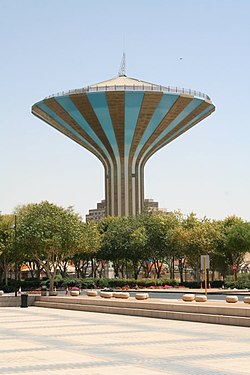| Riyadh Water Tower | |
|---|---|
| برج مياه الرياض | |
 Riyadh Water Tower viewed from the Murabba Square, 2007 Riyadh Water Tower viewed from the Murabba Square, 2007 | |
| Alternative names | Burj al-Khazzaan Khazzaan Murabba |
| Record height | |
| Tallest in Saudi Arabia from 1971 to 1981 | |
| Surpassed by | Riyadh TV Tower |
| General information | |
| Type | Water tower |
| Location | King Faisal Road, King Abdul Aziz Historical Centre, al-Fouta, Riyadh, Saudi Arabia |
| Coordinates | 24°38′42″N 46°42′44″E / 24.64500°N 46.71222°E / 24.64500; 46.71222 |
| Construction started | 1969 |
| Completed | 1971 |
| Height | 61 meters |
| Technical details | |
| Structural system | standard reinforced concrete, prestressed concrete |
| Design and construction | |
| Architect(s) | Sune Lindström |
| Main contractor | AB Vattenbyggnadsbyrån |
Riyadh Water Tower (Arabic: برج مياه الرياض), locally known as Burj al-Khazzaan (Arabic: برج الخزان, lit. 'the reservoir tower') or simply al-Khazzaan (Arabic: الخزان, lit. 'the reservoir'), is a 61-meters tall conical-shaped cylindrical water tower and a prominent cultural landmark in the al-Futah neighborhood of Riyadh, Saudi Arabia. Designed by Swedish architect Sune Lindström and modeled after the Svampen water tower in Örebro, Sweden, it was the tallest structure in the country at the time of its inauguration in 1971 and is today located within the precincts of al-Watan Park in the King Abdulaziz Historical Center. The famous Khazan Street in the city is named after the water tower.
Overview and background


As Riyadh underwent unprecedented expansion and modernization during the 1960s and 1970s, the city lacked a water-supply network to fulfil the needs of its residents. The then Saudi government led by King Faisal tasked the agriculture ministry to come up with a solution by constructing a water tower. The ministry later gave the project to a Swedish architect Sune Lindström in 1969 who worked for the now defunct Stockholm-based Vattenbyggnadsbyrån (VBB) engineering company (later acquired by Sweco in 1997) to develop and implement a plan for a modern water-supply system for Riyadh. Lindström and VBB had simultaneously been employed by the Kuwaiti government as well for the design and construction of the Kuwait Water Towers.
The ministry chose the site upon the ruins of a demolished casino located in close proximity of the Murabba Palace compound for the construction of the water tower to cater the needs of neighborhoods in the vicinity like al-Malazz, Manfuhah and Shumaisi.
The tower contains two tanks, the first one has a filling capacity of 12,000 cubic meters, with the highest water level reaching 51 meters above the ground. The second one has a filling capacity of 350 cubic meters for emergency use during extreme shortages.
It was repainted in 1997 during the reign of King Fahd to observe the upcoming hundredth anniversary of the 1902 Battle of Riyadh.
References
- Elsheshtawy, Yasser (2021-09-27). Riyadh: Transforming a Desert City. Routledge. ISBN 978-1-000-46064-3.
- Bsheer, Rosie (2020-09-22). Archive Wars: The Politics of History in Saudi Arabia. Stanford University Press. ISBN 978-1-5036-1258-7.
- "أبرز المباني والأبراج في السعودية خلال 50 عاماً | مجلة سيدتي". www.sayidaty.net (in Arabic). Retrieved 2022-09-14.
- - برج مياه الرياض ... معجزة البناء من الأعلى! - صحيفة الرياض - 24 - اغسطس - 2013 Archived 2017-01-18 at the Wayback Machine
- "تاريخ بناء برج المياه في الرياض وصور قديمة له". المرسال (in Arabic). Retrieved 2022-09-14.
- مجلة الفيصل: العدد 165 (in Arabic). مركز الملك فيصل للبحوث والدراسات الإسلامية. 1990-10-01.
- "رحلة إلى مركز الملك عبد العزيز التاريخي". www.al-jazirah.com. Retrieved 2022-09-14.
- Al-Khamis, Omaima (2019-06-13). Sea-Wafted Women. Dorrance Publishing. ISBN 978-1-64426-288-7.
- Kultermann, Udo (1999). Contemporary Architecture in the Arab States: Renaissance of a Region. McGraw-Hill. ISBN 978-0-07-036831-6.
- الهطلاني, الدكتورة مضاوي حمد الناصر (1996-11-25). مدينة الرياض: دراسة تاريخية في التطور السياسي والاقتصادي والاجتماعي والثقافي 1902 - 1975 م / 1320 - 1395 هـ (in Arabic). OBEIKAN Education. ISBN 978-9960-20-235-8.
- Haṭalānī, Muḍāwī Ḥamad al-Nāṣir (1996). Madīnat al-Riyāḍ: dirāsah tārīkhīyah fī al-taṭawwur al-siyāsī wa-al-iqtiṣādī wa-al-ijtimāʻī wa-al-thaqāfī, 1902-1975 M./ 1320-1395 H. (in Arabic). Maktabat al-ʻUbaykān.
- "تاريخ بناء برج المياه في الرياض وصور قديمة له". المرسال (in Arabic). Retrieved 2022-09-14.
- "الخرج اليوم | بني على أنقاض". موقع نبض. Retrieved 2022-09-14.
- السيد, نور (2020-06-15). ""معجزة البناء من الأعلى".. كشف معلومات مثيرة عن برج المياه بالرياض وقصة بنائه العجيبة !- فيديو". صحيفة المرصد (in Arabic). Retrieved 2022-09-14.
- "فرنسي يطور برج مياه الرياض بالتعاون مع الثقافة السعودية". www.albawabhnews.com. 2019-04-07. Retrieved 2022-09-14.
- "تحفة معمارية علي أنقاض كازينو.. ماذا تعرف عن قصة بناء برج المياه بالرياض". صدى البلد (in Arabic). 2020-06-15. Retrieved 2022-09-14.
- "برج الخزان بالرياض معلم حضاري يزين حديقة الوطن - الهادي التليلي". www.al-jazirah.com. Retrieved 2022-09-14.
- Saudi Arabia. Information Office of the Royal Embassy of the Kingdom of Saudi Arabia. 1994.